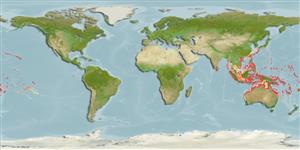Common names from other countries
Environment: milieu / climate zone / depth range / distribution range
Ekologi
marina revassocierade; djupintervall 0 - 36 m (Ref. 1602). Tropical; 30°N - 30°S, 77°E - 124°W
Indo-Pacific: Sri Lanka to the Hawaiian, Marquesan and Ducie islands, north to southern Japan, south to Lord Howe and Rapa Islands; throughout Micronesia.
Size / Vikt / Age
Maturity: Lm ? range ? - ? cm
Max length : 20.0 cm TL hane/ej könsbestämd; (Ref. 9710)
Taggstrålar i ryggfenan (totalt) : 12 - 13; Mjukstrålar i ryggfenan (totalt) : 24 - 28; Taggstrålar i analfenan: 3; Mjukstrålar i analfenan: 20 - 23. Body is white with orange to orange-brown oblique bands on the sides. Two broad yellow-edged black bars are on the head; one running across the eye and another on the snout (Ref. 4855). Snout length 2.6-3.2 in HL. Body depth 1.3-1.6 in SL (Ref. 90102).
Occur in clear waters and coral-rich areas of lagoon and seaward reefs. However, only common in seaward reefs (Ref. 1602). Benthopelagic (Ref. 58302). Juveniles are solitary, living among branching corals, while adults are almost always in pairs and are home-ranging. Feed exclusively on coral tissue (Ref. 1602). Oviparous (Ref. 205). Form pairs during breeding (Ref. 205). Minimum depth reported taken from Ref. 128797.
Life cycle and mating behavior
Maturities | Reproduktion | Spawnings | Egg(s) | Fecundities | Larver
Distinct pairing (Ref. 205). Monogamous mating is observed as obligate, genetic and social (Ref. 52884).
Myers, R.F., 1991. Micronesian reef fishes. Second Ed. Coral Graphics, Barrigada, Guam. 298 p. (Ref. 1602)
IUCN Red List Status (Ref. 130435)
CITES (Ref. 128078)
Not Evaluated
Threat to humans
Harmless
Human uses
Fiskeri: mindre kommeriell; Akvarium: Kommersiell
Verktyg
Special reports
Download XML
Internet-källor
Estimates based on models
Preferred temperature (Ref.
115969): 24.8 - 29.3, mean 28.4 (based on 2134 cells).
Phylogenetic diversity index (Ref.
82804): PD
50 = 0.5000 [Uniqueness, from 0.5 = low to 2.0 = high].
Bayesian length-weight: a=0.02291 (0.01133 - 0.04632), b=3.00 (2.83 - 3.17), in cm Total Length, based on LWR estimates for this Genus-body shape (Ref.
93245).
Trofisk nivå (Ref.
69278): 3.3 ±0.61 se; based on food items.
Resiliens (Ref.
120179): Hög, lägsta populationsfördubblingstid mindre än 15 månader (Preliminary K or Fecundity.).
Fishing Vulnerability (Ref.
59153): Low vulnerability (10 of 100).
